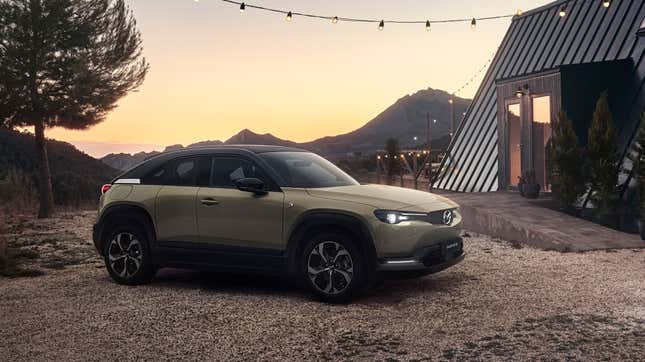The Mazda MX-30 is a compact electric SUV with some issues. The big one is range, specifically that there isn’t enough of it, as the paltry 35.5-kWh battery only offers an EPA-estimated 100 miles on a full charge. To address that, Mazda is repurposing its beloved rotary into a range extender for the battery, granting it a much healthier total 373 miles with a full tank and full charge, 53 of those being all-electric.
On Thursday, Mazda announced it finally started production of the MX-30 e-Skyactiv R-EV in Hiroshima — its first production car with a spinning engine since the divisive RX-8. The two-plus-two’s Renesis 13B-MSP wasn’t particularly well made, had a poor exhaust design and, of course, was beset by horribly unreliable apex seals. As such, the RX-8 was the car my old colleague Raphael Orlove charged with helping to “kill the rotary engine.”
Mazda’s tactic today is different. It’ll use the rotary to generate electricity to replenish the batteries. As a result, the engine can run at the ideal load speed at all times for optimal efficiency. “Efficiency” isn’t a trait anyone’s ever ascribed to the rotary — fuel efficiency, at least — so that’s a good place to start.
There’s one problem: Mazda still hasn’t yet committed to offering the (inhales) MX-30 e-Skyactiv R-EV in the States. Which is weird, because no driver is more range anxious than the American driver. The MX-30 is still only available in California as it is, likely to satisfy emissions regulations there, and Californians have a habit of being a little more forgiving toward EVs in general, even the ones that don’t really deserve it.

The latest official line on the subject came in February. At the time, Mazda North America CEO Jeff Guyton told Automotive News “MX-30 has been selling quite well in Europe, and we’re going to prioritize MX-30 rotary for Europe and for Japan where the product is more suited to the roads and those customers. It doesn’t mean it’s a no for the U.S.”
Today on this side of the pond Mazda is concentrating on the CX-90, which figures to be paying dividends. A recent report from MotorBiscuit citing numbers from GoodCarBadCar said the automaker’s sales for the month of May were 117 percent better than over the same period in 2022, totaling 33,262 units. May was the CX-90's first full month on sale, and the big, straight-six-powered (or plug-in hybrid, if you’re so inclined) SUV’s been generally well-received by critics, including our own Lawrence Hodge.
But Mazda’s also said that North America is the reason why it needs to concentrate on electrification, and that’s got to bear out in product sooner or later. Electric vehicles are expected to represent between a quarter and 40 percent of the brand’s global sales by the end of the decade, but the full-press ramp up for that won’t happen until about 2028. In the meantime, the company’s in talks with Panasonic to squander away the batteries it needs.
Taken altogether, it seems like the R-EV is destined for North America eventually. Otherwise what incentive would Mazda have to keep asking everyone to hold out hope? If nothing else, Mazda’s interest in the rotary’s second life as an EV booster doesn’t seem to be passing. A slew of new patents suggest its engineers really believe there’s something there.
Correction 1:40 p.m. ET, June 22, 2023: An earlier version of this story stated the MX-30 R-EV’s rotary engine was the first of its kind Mazda has produced in 11 years. Mazda has actually continued producing rotary engines and spare parts for them even after the RX-8's discontinuation, as the company outlined in a 2021 blog post.